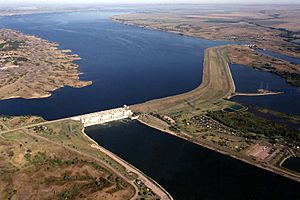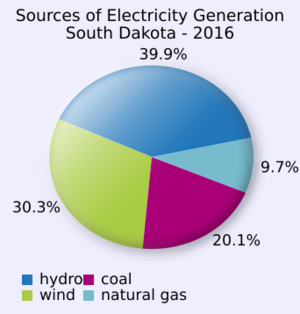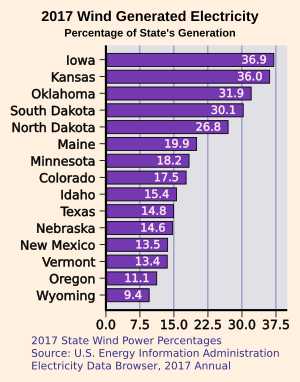Renewable energy in South Dakota facts for kids
Renewable Energy in South Dakota is all about using natural resources that can be replaced, like sunshine, wind, and water, to make power. South Dakota is really good at this! It's one of the top states in the U.S. for getting its electricity from renewable sources.
Imagine this: most of the power used in South Dakota comes from clean energy, often more than 70 percent! By 2011, South Dakota was the very first U.S. state to get at least 20% of its electricity from wind power. And by 2022, an amazing 84% of its power came from renewable sources, mostly wind! This means less pollution and a healthier planet.
Contents
Making Fuel from Plants: Biofuels
Biofuels are special fuels made from plants, like corn or soybeans. South Dakota uses a lot of its crops to make these fuels.
Ethanol Fuel: Power from Corn
South Dakota is a big part of the "Corn Belt," a region where lots of corn is grown. Because of this, it's a leader in making ethanol fuel from corn. Ethanol is often mixed with gasoline to power cars.
Back in 2011, South Dakota had 15 factories that made ethanol. Together, they could produce over 1 billion gallons of ethanol every year! A company called POET, one of the world's biggest ethanol makers, is located in Sioux Falls. In 2009, these ethanol plants used about 291 million bushels of corn. That's a lot of corn!
Biodiesel: Fuel from Oil Seeds
South Dakota also grows crops like soybeans, which have oil in them. This oil can be used to make biodiesel. There's one biodiesel factory in Alexandria. However, in 2011, it wasn't running because it wasn't making enough money.
Interestingly, some of POET's ethanol plants have found a way to get a type of corn oil from the leftover parts of corn after making ethanol. This corn oil can then be used to make biodiesel!
Generating Electricity from Nature
South Dakota uses powerful natural resources to create electricity.
Hydroelectric Power: Energy from Water
The main way South Dakota makes electricity is through hydropower. This means using the power of moving water. Four big dams on the Missouri River are responsible for most of South Dakota's hydropower.
These dams are like giant power stations:
- The Gavins Point Dam near Yankton
- The Fort Randall Dam near Pickstown
- The Big Bend Dam near Fort Thompson
- The Oahe Dam near Pierre
Each dam has huge generators that turn the force of the water into electricity. For example, the Oahe Dam can generate 786 megawatts (MW) of power!
Wind Power: Harnessing the Breeze
Wind power makes up about a quarter of all the electricity made in South Dakota. The state has 583 wind turbines, which are like giant windmills, that can produce a total of 977 MW of wind energy.
Even though South Dakota doesn't make as much electricity overall as some other states, its wind turbines are very efficient. This means South Dakota is a leader in how much of its electricity comes from wind.
Experts think that South Dakota could install even more wind turbines, possibly over 800,000 MW of capacity! The biggest challenge right now is getting the electricity from the wind farms to where people need it. New power lines are being built to help with this.
In 2012, South Dakota's wind turbines were the most efficient in the country, working at 42.9 percent of their full power. Some big wind projects in the state include the Titan Wind Project and the Tatanka Wind Farm.
Solar Power: Catching the Sun's Rays
Solar power uses sunlight to make electricity. As of 2015, South Dakota had a small amount of solar power connected to its electricity grid. However, South Dakota has a lot of potential for solar power, ranking 14th in the country for how much sunshine it gets!
South Dakota's Renewable Energy Goal
South Dakota has set a goal to get 10% of its electricity from renewable energy sources by 2015. This was a voluntary goal, meaning the state chose to work towards it.




